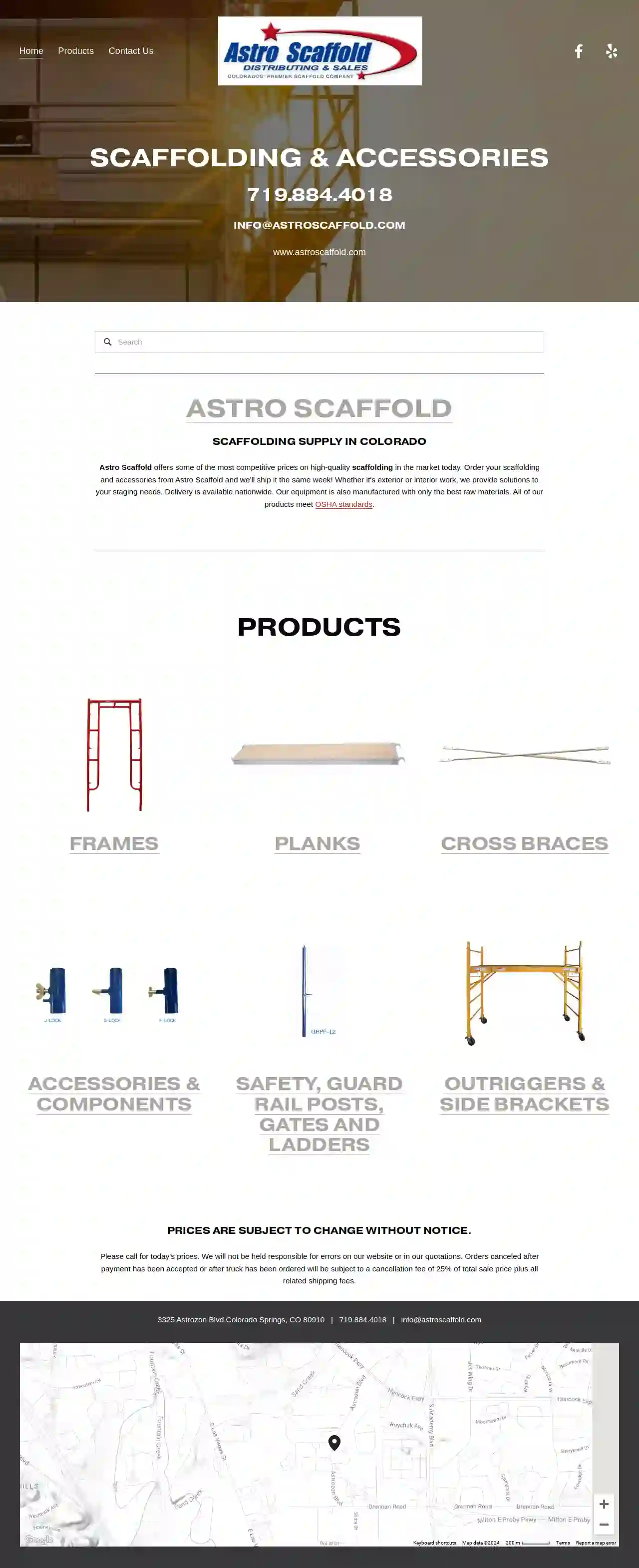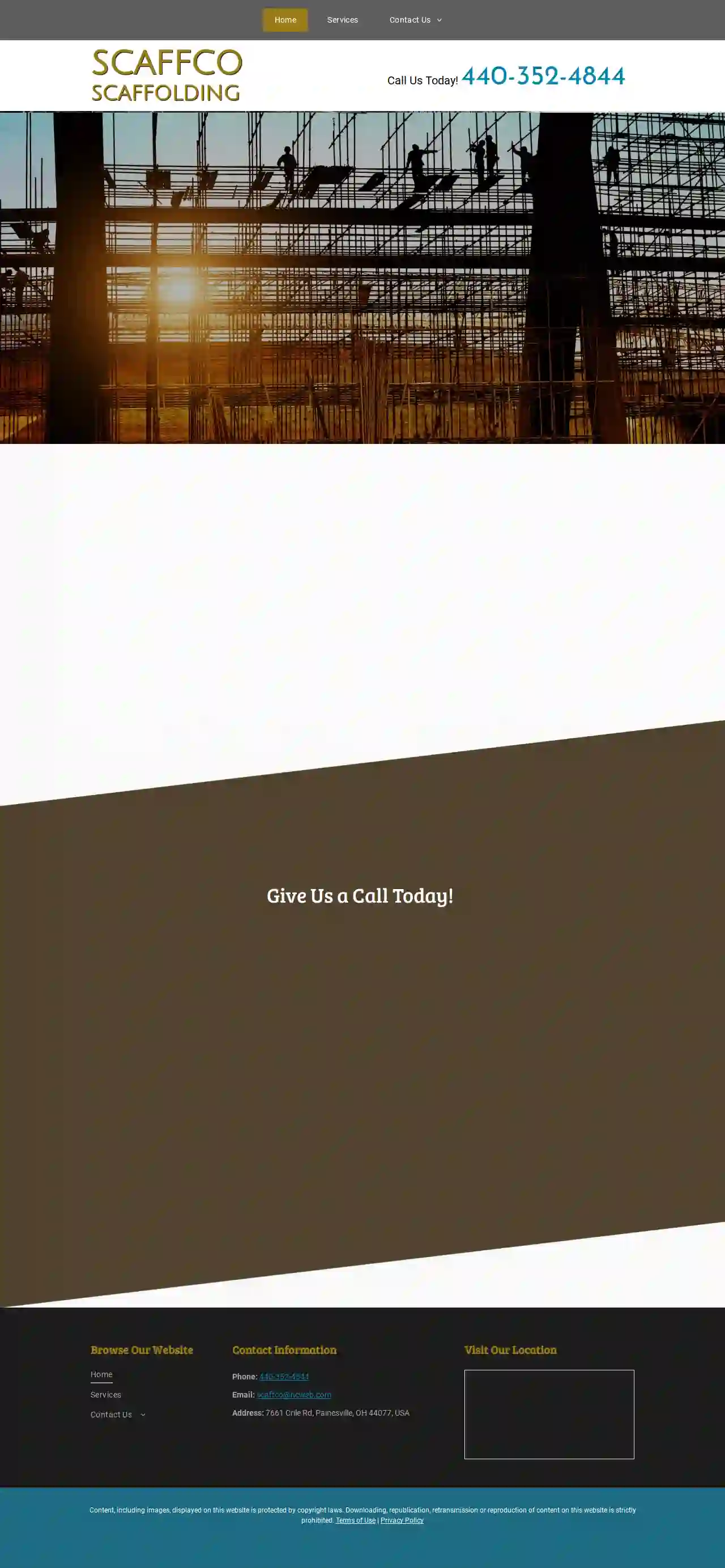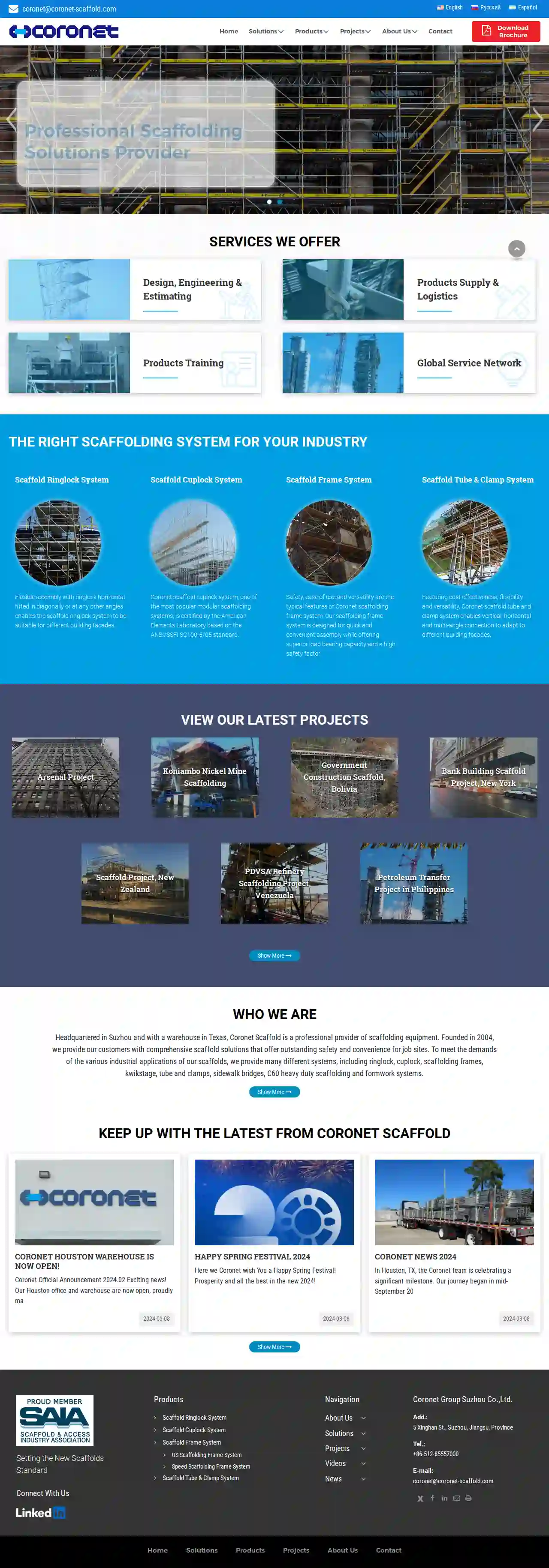Scaffolding Companies Crockett
Find top Scaffolding Experts in Crockett
Get up to 3 Scaffolding Specialists quotes for your project today! Compare profiles, reviews, accreditations, portfolio, etc... and choose the best deal.

Astro Scaffold Distributing and Sales
4.85 reviews3325 Astrozon Blvd, Colorado Springs, 80910, USAstro Scaffold is a leading scaffolding supply company in Colorado, offering high-quality scaffolding and accessories at competitive prices. Our products meet OSHA standards and are manufactured with the best raw materials. We provide solutions for both exterior and interior work, with delivery available nationwide. Our scaffolding supply includes frames, planks, cross braces, accessories, and components, as well as safety equipment like guard rail posts, gates, and ladders. We also offer outriggers and side brackets to ensure safe and secure scaffolding. At Astro Scaffold, we pride ourselves on our excellent customer service and fast shipping. We'll ship your scaffolding and accessories the same week you order them. Please note that prices are subject to change without notice, and we recommend calling for today's prices.
- Services
- Why Us?
- Accreditations
- Gallery
Get Quote
TM Platforms Inc.
250 Royal Oak Road, Cambridge, N3E 0A4, USAt TM Platforms, we pride ourselves on being a professional scaffolding partner that offers 24/7 responsive service, competitive pricing, and expertise to help make your next project run safely and smoothly. As part of the Trade-Mark Industrial group of companies, we are relentlessly committed to safety and offer the knowledge, equipment, and protection products you need for a complete and efficient scaffolding solution. Our team of certified scaffolding installers hold safety paramount in their day-to-day activities and are technically trained to strictly comply with Ontario's construction regulations. We serve customers in Southwestern Ontario, including Kitchener-Waterloo, Cambridge, Guelph, London, Hamilton, Burlington, St. Catharines, Niagara, the GTA, and everything in between.
- Services
- Why Us?
- Accreditations
- Our Team
- Gallery
Get Quote
Southwest Scaffolding & Supply
4.840 reviews5030 Dexham Rd., Ste. 101, Rowlett, 75088, USWelcome to Southwest Scaffolding & Supply, your premier source for scaffolding rental and sales. With over 15 years of experience, we provide top-quality scaffolding solutions for various industries. Our team of experts is dedicated to helping you find the right scaffolding equipment for your project. We offer a wide range of scaffolding products, including scaffolding sets, snap-on scaffolding, scaffold frames, and more. Our mission is to provide exceptional customer service, ensuring your satisfaction with our products and services. Contact us today to learn more about our scaffolding solutions and how we can help you achieve your goals.
- Services
- Why Us?
- Accreditations
- Our Team
- Gallery
Get Quote
FORT WORTH SCAFFOLDING RENTAL
52 reviewsDallas, USFt Worth Scaffolding Rental: Your Reliable Partner for Safe and Efficient Access Ft Worth Scaffolding Rental is your trusted source for high-quality scaffolding solutions in Fort Worth and the surrounding areas. We understand the importance of safety and efficiency when it comes to working at heights, and we're committed to providing you with the right equipment and support to get the job done right. Whether you're a professional contractor, a homeowner tackling a DIY project, or a business needing temporary access for maintenance, we have the scaffolding you need. Our inventory includes a wide range of indoor and outdoor scaffolding options, all meticulously maintained and ready to rent. We pride ourselves on our exceptional customer service. Our team is always available to answer your questions, provide expert advice, and ensure you have the right scaffolding for your specific needs. We're dedicated to making your experience with us as smooth and hassle-free as possible. Contact us today for a free quote and let us help you reach new heights!
- Services
- Why Us?
- Gallery
Get Quote
BETCO Scaffolds
52 reviews1626 Enid Street, Houston, 77009, USBETCO Scaffolds is a leading scaffolding rental company in Texas, providing top-notch scaffolding solutions for construction projects. With a rich history dating back to 1945, the company has expanded its operations to include branch locations in Houston, Dallas, San Antonio, and Beaumont, serving all of Texas and parts of Oklahoma and Louisiana. BETCO Scaffolds is recognized for its dedication to safety, quality products, and excellent customer service. The company has been awarded the ABC Excellence in Construction Award multiple times and has received the ABC Platinum Safety Award for seven consecutive years. BETCO Scaffolds is privately owned by the Gilbreath Family, spanning three generations, and is known as one of the most innovative scaffolding companies in the country. BETCO's standards for safety and professional service remain their top priority with every project.
- Services
- Why Us?
- Accreditations
- Our Team
- Testimonials
- Gallery
Get Quote
Scaffco Scaffolding
4.85 reviewsPainesville, OH, 7661 Crile Rd, 44077, USScaffco Scaffolding & Supply Company, Inc., is a full-service scaffold company. Renting, delivering, picking up, erecting, dismantling and selling scaffold are what we do best. With more than 35 years of experience in the scaffold industry, our staff is more than capable of handling any and all of the scaffold needs your company may have. If you need a certain application looked at, one of our professionals will come to your job site, inspect the situation and come up with a solution to your needs. Safety is a high priority with our company. Our labor crews will consult with your superintendant to ensure that they are satisfied with the quality of the scaffold build as well as the safety of the job before considering it complete. Scaffco Scaffolding & Supply Company, Inc., is a company that can be of much service to yours. If you have any questions, please contact us at 440-352-4844 or 440-352-1810. Our staff will be able to assist you with any questions you may have. Give Us a Call Today!
- Services
- Why Us?
- Accreditations
- Our Team
- Testimonials
- Gallery
Get Quote
Coronet Scaffold USA
5 Xinghan St., Suzhou, Jiangsu, Province, USCoronet is a global supplier of premium quality scaffolding products offering complete Scaffolding Solutions to all our clients all over the world. Founded in 2004, we provide our customers with comprehensive scaffold solutions that offer outstanding safety and convenience for job sites. To meet the demands of the various industrial applications of our scaffolds, we provide many different systems, including ringlock, cuplock, scaffolding frames, kwikstage, tube and clamps, sidewalk bridges, C60 heavy duty scaffolding and formwork systems.
- Services
- Why Us?
- Accreditations
- Gallery
Get Quote
Sunbelt Rentals
4.131 reviewsSunbelt Rentals, Grand Prairie, TX, 1234 Sunbelt Blvd, 75050, USSunbelt Rentals is a leading provider of equipment rentals, offering a wide range of aerial work platforms, scaffolding, ladders, cranes, boom trucks, and more. With a commitment to customer support, they provide resources such as FAQs, rental tracker, and a customer support hotline. Sunbelt Rentals also offers careers, veterans program, and benefits for employees. They have multiple locations and offer equipment for purchase.
- Services
- Why Us?
- Accreditations
- Our Team
- Testimonials
- Gallery
Get Quote
TNT Equipment Co.
54 reviews2816 Sylvan Ave, Dallas, 75212, USTNT Equipment Company is a leading provider of construction equipment rentals, sales, and services. With a strong presence in Ohio, Texas, Florida, and the Carolinas, they offer a wide range of equipment, including mast climbing and conventional scaffolding, Gradall & JLG rough terrain forklifts, EZ Grout mixers, and more. Their experienced team provides installation and dismantle services for all their products, ensuring customers get the equipment they need to complete their projects efficiently. With a commitment to quality and customer satisfaction, TNT Equipment Company has become a trusted partner for construction professionals across the United States.
- Services
- Why Us?
- Accreditations
- Gallery
Get Quote
Industrial Ladder & Supply Co
3.45 reviews1250 Tamiami Trail N, Suite 210, Naples, FL, 34102, USIndustrial Ladder & Supply Co., Inc. is a leading provider of ladders, scaffolding, and other construction equipment. With a corporate office in Naples, FL, the company offers a wide range of products including ladders, extension ladders, step stools, and more. Their mission is to provide high-quality, safe, and reliable products to the construction industry.
- Services
- Why Us?
- Accreditations
- Our Team
- Testimonials
- Gallery
Get Quote
Over 2,353+ Scaffolding Companies on our directory
Our scaffolding companies operate in Crockett and surroundings!
ScaffoldingHQ has curated and vetted the Best Scaffolding Businesses in and around Crockett. Find a reliable contractor today.
Frequently Asked Questions About Scaffolding Companies
- Traditional and highly versatile.
- Components (tubes, clamps, boards) are assembled on-site.
- Adaptable to complex shapes and structures.
- Requires skilled labor and more time for erection.
- Pre-engineered, modular components.
- Faster and easier to erect.
- Often has higher load capacities.
- May be less versatile for complex shapes.
- Tube and Clamp Scaffolding: A traditional and versatile system using individual tubes and clamps. It's highly adaptable but requires more time to erect.
- System Scaffolding: Pre-engineered systems with modular components that fit together quickly. They offer speed and efficiency, especially for larger projects.
- Suspended Scaffolding: Hung from a roof or overhead structure, ideal for high-rise buildings or areas with limited ground access.
- Mobile Scaffolding: Mounted on wheels, allowing easy movement around a worksite. Suitable for tasks like painting or plastering.
- Specialized Scaffolding: Cantilever scaffolding, rolling towers, and other specialized systems cater to specific needs.
- Project Size and Complexity: The height, configuration, and accessibility of the scaffolding will influence the amount of materials and labor required.
- Scaffolding Type: Different scaffolding systems (tube and clamp, system scaffolding, suspended scaffolding) have varying costs.
- Duration of Rental: The length of time you need the scaffolding will affect the overall rental price.
- Location: Labor costs and material availability can differ based on your location.
- Additional Services: Some companies may offer additional services like erection, dismantling, or transportation, which can add to the cost.
- Stability and Level: The scaffolding is level and firmly supported by a solid foundation.
- Secure Connections: All components (tubes, clamps, fittings) are properly connected and tightened.
- Guardrails and Toeboards: Adequate guardrails and toeboards are in place to prevent falls.
- Platforms and Decking: Platforms are secure, free from damage, and provide adequate working space.
- Access and Egress: Safe access and exit points are available (ladders, stairs).
- Weather Protection: Appropriate measures are in place to protect workers from adverse weather conditions (e.g., wind screens, covers).
- Clearance from Hazards: The scaffolding is a safe distance from power lines, trees, or other potential hazards.
- Scaffolding Tag: The scaffolding tag is up-to-date and displays the last inspection date, maximum load capacity, and any restrictions.
What is the difference between tube and clamp scaffolding and system scaffolding?
Tube and Clamp Scaffolding:
What are the different types of scaffolding?
How much does scaffolding cost to hire in the USA?
What should I look for during a scaffolding inspection?
What is the difference between tube and clamp scaffolding and system scaffolding?
Tube and Clamp Scaffolding:
- Traditional and highly versatile.
- Components (tubes, clamps, boards) are assembled on-site.
- Adaptable to complex shapes and structures.
- Requires skilled labor and more time for erection.
- Pre-engineered, modular components.
- Faster and easier to erect.
- Often has higher load capacities.
- May be less versatile for complex shapes.
What are the different types of scaffolding?
- Tube and Clamp Scaffolding: A traditional and versatile system using individual tubes and clamps. It's highly adaptable but requires more time to erect.
- System Scaffolding: Pre-engineered systems with modular components that fit together quickly. They offer speed and efficiency, especially for larger projects.
- Suspended Scaffolding: Hung from a roof or overhead structure, ideal for high-rise buildings or areas with limited ground access.
- Mobile Scaffolding: Mounted on wheels, allowing easy movement around a worksite. Suitable for tasks like painting or plastering.
- Specialized Scaffolding: Cantilever scaffolding, rolling towers, and other specialized systems cater to specific needs.
How much does scaffolding cost to rent in the USA?
- Project Size and Complexity: The height, configuration, and accessibility of the scaffolding will influence the amount of materials and labor required.
- Scaffolding Type: Different scaffolding systems (tube and clamp, system scaffolding, suspended scaffolding) have varying costs.
- Duration of Rental: The length of time you need the scaffolding will affect the overall rental price.
- Location: Labor costs and material availability can differ based on your location.
- Additional Services: Some companies may offer additional services like erection, dismantling, or transportation, which can add to the cost.
What should I look for during a scaffolding inspection?
- Stability and Level: The scaffolding is level and firmly supported by a solid foundation.
- Secure Connections: All components (tubes, clamps, fittings) are properly connected and tightened.
- Guardrails and Toeboards: Adequate guardrails and toeboards are in place to prevent falls.
- Platforms and Decking: Platforms are secure, free from damage, and provide adequate working space.
- Access and Egress: Safe access and exit points are available (ladders, stairs).
- Weather Protection: Appropriate measures are in place to protect workers from adverse weather conditions (e.g., wind screens, covers).
- Clearance from Hazards: The scaffolding is a safe distance from power lines, trees, or other potential hazards.
- Scaffolding Tag: The scaffolding tag is up-to-date and displays the last inspection date, maximum load capacity, and any restrictions.